Madagascar is roughly the shape of a 1000-mile-long left foot, with the heel in the south, crossed by the tropic of Capricorn, Tana – the capital – in the instep and the big toe in the north pointing towards the Horn of Africa.
September 2024 saw us touch down on a little corn on the second toe, intent on travelling to the big toe. This was my third visit to the Great Red Island. This time we’d arrived at Madagascar’s second international airport sited not – as you might expect – on the ‘mainland’ of Madagascar but on its largest offshore island, Nosy Be. The name, pronounced Noosy Bay, means simply big island. Many visitors opt to just chill on the wonderful palm-fringed beaches there but we eschewed such pleasures because we were on a mission to revisit some of the reserves and national parks to the north.
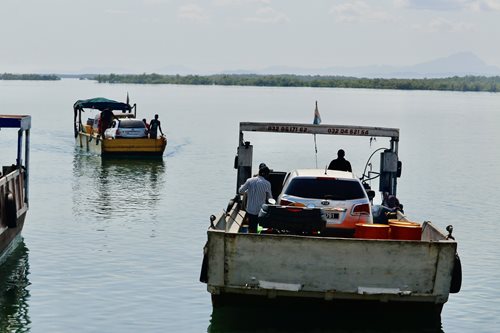 |
| Ferries leaving Nosy Be for the 'mainland' at Ankify |
We took a relatively speedyboat ferry to the busy little port of Ankify. Then we could drive part of the Route Nationale 6 to Antsiranana aka Diego Suarez, rejoining the last part of a route I’d first followed – squeezed into a bush taxi in 1981.
The roads were little better than in the 1980s. There were some improvements but the 2024 cyclone season had been horrendous and several major bridges destroyed forcing us to take meandering diversions to ford rivers. Even so we managed the 250km to Antsiranana in six hours, and could tumble out of the car for a stretch, and to enjoy vistas of the world’s second largest natural harbour, before heading due west. The last 30km took another couple of hours because the dirt road was so winding and in such a bad condition.
Arriving at the idyllic beach at Ampasimdava, we needed a swim, cold Three Horses Beers
(grande modele) and then the world came back into focus. Sandpipers and a surprise Eurasian curlew picked around at the strandline, while beautifully marked Namaqua doves waddled in the dunes and storks flew overhead. An impressive stand of huge portly baobab trees dominated the southern horizon.
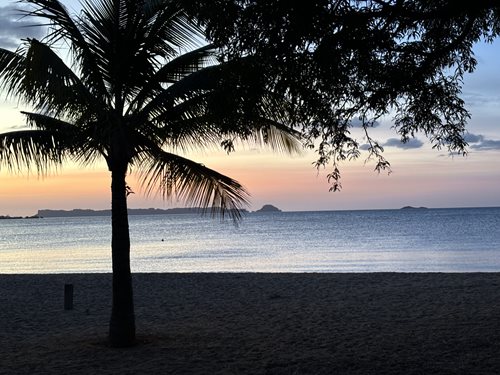 |
| Even from a distance the island of Nosy Hara looks steep and forbidding |
Next morning we made the one-hour crossing in a rather under-powered boat whose engine spluttered and struggled the 10 km to the uninhabited island of Nosy Hara. Its name roughly translates as mountainous island and with limestone cliffs rising sheer out of the sea it is well-named. I wondered how we could possibly land. The boatman though took us to the western, ocean-facing side of the island and we waded ashore and onto an inviting sheltered beach. Our guide, Mika, marshalled the helpers he’d employed and they established camp on a sandy terrace well above the high tide mark. We were walled in by forbidding crags but there was enough flat ground for shrubs and small trees to grow. Huge butterflies flapped by and the soundscape spoke of an array of small birds, geckos and vaza parrots.
Our first excursion took us along a dry stream-bed which was pockmarked with crab burrows and then we walked steeply up through broadleaf forest past a massive fig and other trees I couldn’t name. The cliffs were festooned with roots and lianas visited by sunbirds. Our guide kept walking off the path to rummage in the leaf litter and I feared he might anger a scorpion. On my previous visit to Madagascar, I had been stung and the expressions on my team-mates’ faces suggested they thought I would die. I found this observation unnerving. I was in a lot of pain for 36 hours and still don’t have normal sensation in the stung finger.
When our Nosy Hara guide shouted something, my concern for him increased. But maybe he knew there were no scorpions on this little island as he was smiling and beckoning us.
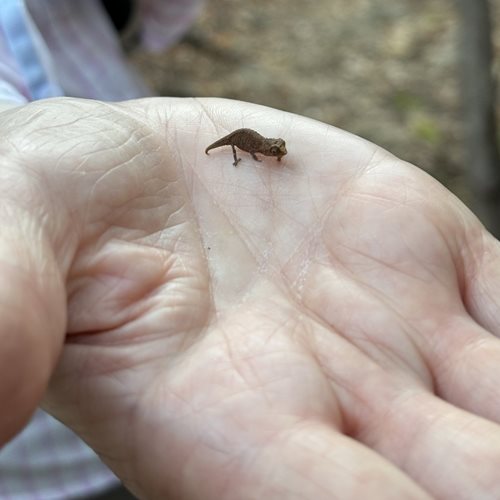 |
| Brookesia micra - probably the world's second smallest repile - on my sister's hand |
In the palm of his hand was a creature that most might have mistaken for an insect as nose to tail-tip it was less than two centimetres long but it was a perfect chameleon in miniature, with swivel-eyes, mitten feet, and that characteristic hesitant rocking style of walking. This was the Nosy Hara leaf chameleon
Brookesia micra which until 2021 was considered the smallest reptile on earth. Then
Brookesia nana was discovered, with its maximum length only 22mm, it undercut
B. micra’s 30mm.
Brookesia micra is endemic to Nosy Hara, so is vulnerable to anything disturbing suitable habitat on the island. The guide replaced this tiny treasure back in its leafy home, pointed out a 30-centimetre-long bright green day gecko, and led us on up to a spiky summit. Here we could look over an azure sea east towards the Madagascar ‘mainland’, and west back across the 500-metre width and along the three-kilometre length of this gem of an island.
Back down in camp we arrived to some commotion centred around the walless shelter described as a kitchen. As the cook set about lighting up the charcoal, he’d noticed that a large boa was snuggled up amongst the embers left by previous visitors. It was beautifully marked in shades of tan, chestnut, coffee and ebony. It wasn’t until it decided to leave that we saw that it was muscly and over two metres long. I felt bad that we’d disturbed it, but it was back in its favourite resting spot in the kitchen next morning.
One of the friends I made during our 1986 expedition was Benjamin a bearded Frenchman who taught in the high school in Antsiranana. He was so enthusiastic about lemurs that his pupils gave him the not entirely flattering nickname of Babakoto. This is Malagasy for the indri – the largest surviving lemur, a leaf-eater, not known for its intellect. Only on arriving on Nosy Hara, did I recall conversations we’d had about lemur conservation and Benjamin’s fears for Crowned Lemurs. We’d bonded because I was also passionate about and fearful for this endearing species. I’d just emerged from spending a couple of months following Crowned Lemurs in the forests of nearby Ankarana, completing the first scientific study of the species in the wild. It was clear to us both that they were endangered, and Benjamin took it upon himself to release Crowned Lemurs on Nosy Hara, which he thought would be a safe refuge. I asked our local guides about the lemur introductions but I guess they were too young to know of Benjamin’s work. But, then again, they said there were no mouse lemurs on the island either when they have been recorded here.
On our second day, the boatman took us a couple of kilometres further along the island and dropped us on another beach, this time at the northern tip, so that we could walk much of the length of Nosy Hara and back to camp. The landscape felt arid and hostile, and during one rest stop in some scant shade Mika told us a long, complicated story about intertribal wars in the late 1820s. The tales were a little hard to follow but featured the Merina King Radama I from the central highlands of Madagascar who was intent on enslaving the local Antankarana people. The Antankarana are sea-faring fishermen and fled to the island where there was an abundance of hiding places. Mika, who himself was raised amongst lowland fishermen, went on to tell us how Antankarana outwitted the land-loving warmongering Merina and massacred them. The two tribes have never been friends and now restless ghosts haunt Merina visitors.
Our three-kilometre ramble and scramble took us through a parched desperate terrain. Dry-throated and dripping sweat, we negotiated a wonderland of weird limestone formations from which thorny pseudo-cacti called pachypodia sprouted: many had tufts of cute ivory flowers at their tips. Sometimes an odd bright yellow flower blossomed from an apparently dead stick. Plants were armoured, weird-looking, bulbous-bottomed and leafless, or leaves were thick like those of a plant Mika called Napoleon’s hat. Anything growing up on the spiky tsingy needed to store water, or survive dehydration. I didn’t see any evidence of standing water anywhere.
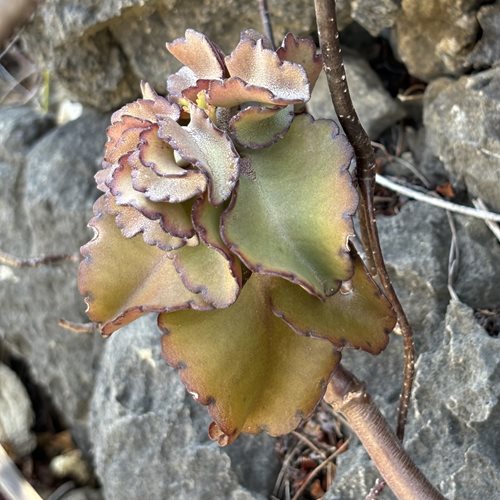 |
| Napoleon's hat |
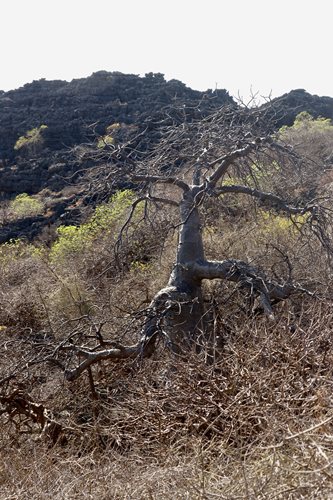 |
| Many of the trees that grow on the island are bulbous bottomed water-storers |
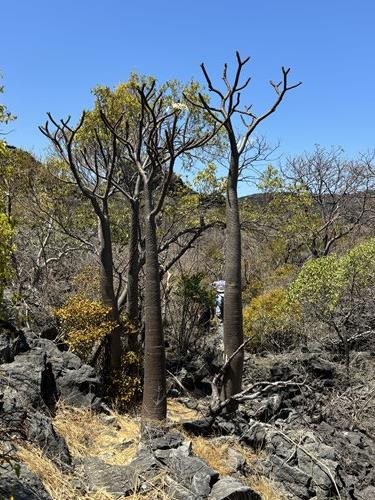 |
| Pachypodia in the dry season on Nosy Hara |
I was on high alert for Crowned Lemur calls but heard none. Sadly, Benjamin’s well-intentioned lemur introductions had failed – for want of water, I guessed. From the savage cliff-tops though we watched turtles lolling in calm clear seas and spectacular, long-tailed tropic birds quartering the ocean.
Another group of visitors had arrived while we’d been out of camp. They were accompanied by a Merina guide and Mika was astonished that she had to resort to speaking French to the locals as she couldn’t understand their northern Malagasy dialect. Perhaps the local guides were also unimpressed; they fed her stories of wars and angry ghosts. That night I was vaguely aware that people were awake and were waving torches around but it didn’t sound like anyone needed medical attention so it wasn’t until morning that we learned that the Merina guide had been spooked by noises in the night, especially leaves flapping against her tent. She had decided that ghosts were after her. There were too plenty of sounds from unseen creatures lurking in the leaflitter – some turned out to be enormous nocturnal hermit crabs. Perhaps the locals had intended to wind her up as there's no love lost between the Antankarana and their historic would-be oppressors. In a land of superstitions, such myths must help keep unwanted visitors away. And some traditions help protect precious wildlife too.
There is more about this trip here
Return to Ankarana and a short piece of creative writing featuring a Malagasy special here
Deep emerald green plus a piece on a trip into the rainforest of the north-east here
Into the Malagasy Rainforest